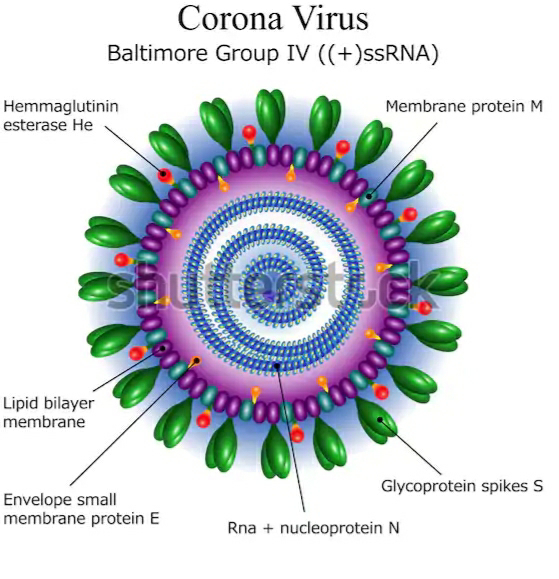Corona viruses are a family of viruses that cause illness ranging from the common cold to more severe diseases such as SARS and Middle East respiratory syndrome (MERS).
Morphology
-Enveloped virus.
-petal or club shaped or crown like peplomer spikes giving appearance of solar corona.
-large(120-160nm) spherical viruses having helical symetry.
-posses liner,positive senses ssRNA of 26 to 32 kbp size,largest among the non-segmented RNA viruses.
Virus Classification
-Group:GroupIV ((+)ssRNA)
-Order:Nidovirales
-Family:Coronaviridae
-Subfamily:Coronavirinae
-Genus:
Alphacoronavirus
Betacoronavirus
Deltacoronavirus
Gammacoronavirus
-Type species
Coronavirus
-Species
Human coronavirus HKU1
Human coronavirus OC43
MERS-CoV
SARS-CoV
Pipistrellus Bat coronavirus HKU5
Human Coronaviruses
-Six recogonised coronaviruses that are known to cause human infection;most of them belong to betacoronavirus except the first two which belongs to alphacoronavirus.
1)Human Coronavirus 229E
2)Human Coronavirus NL63
3)Human Coronavirus OC43
4)Human Coronavirus HKU1
5)SARS-CoV(severe acute respiratory syndrome coronavirus)
6)MERS-CoV(Middle East Respiratory Syndrome Coronavirus)
Mode Of Transmission
-By coughing.
-By sneezing.
-Close personal contact,such as touching. mouth,nose,or eyes or shaking hands.
-Also spread via droplets.
-Rarely spread through the air.
-Also through uterine placental transmission
Epidemiology
-lt was first reported in Saudi Arabia in 2012.
- Since then, several hundreds of cases have been reported from various countries located in and around the Arabian Peninsula such as Saudi Arabia, UAE, Qatar, Oman, Jordan, Kuwait, Yemen, Lebanon and Iran.
-It has recently been reported from Nepal and India too.
-This virus mainly affects the immunocompromised people, pregnant ladies and most commonly old aged people.
Symptoms
-Signs of infection include fever, cough, shortness of breath and breathing difficulties.
-In more severe cases, it can lead to pneumonia, severe acute respiratory syndrome, kidney failure and even death.
Laboratory Diagnosis
- Antigen detection: Coronavirus antigens in the respiratory epithelial cell may be detected by ELISA using specillc monoclonal antibody.
- Electron microscopy can be used to detect enteric coronaviruses from stool.
- RNA detection: RT-PCR assays are useful to detect coronavirus RNA in respiratory secretions and in stool
samples and SARS-CoV RNA from blood.
-Isolation of human coronaviruses in cell culture has been extremely difficult. Traditional tracheal ring culture is no longer in use. SARS-CoV was isolated
from respiratory specimens using Vero cell line.
- Serum antibody detection: ELISA and
hemagglutination inhibition test are available. Rising titer of antibody between acute and convalescent sera can be used to establish the diagnosis.
Treatment and Prevention
-No specific drugs or vaccine available for coronavirus infection.
-control measures include:
1)isolation of patients
2)Quarantine of exposed people
3)Travel restrictions if needed
4)Use of gloves,goggles and respirators by helathcare workers
5)Through and frequent hand washing
6)Avoiding personal contact,such as kissing,or sharing cups or eating utensils,with sick people
7)Avoiding contact with camels,uncooked camel milk or meat
Clinical Manifestation
-Incubation period is about 2-14 days.
-Severe acute respiratory symptoms appear such as fever,cough and shortness of breath may appear.
-some people may develop gastrointestinal symptoms including diarrhea and nausae/vomiting.
-Complications such as pneumonia and kidney failure occur,especially in people with underlying comorbid conditions.




Oh No 😔
ReplyDelete